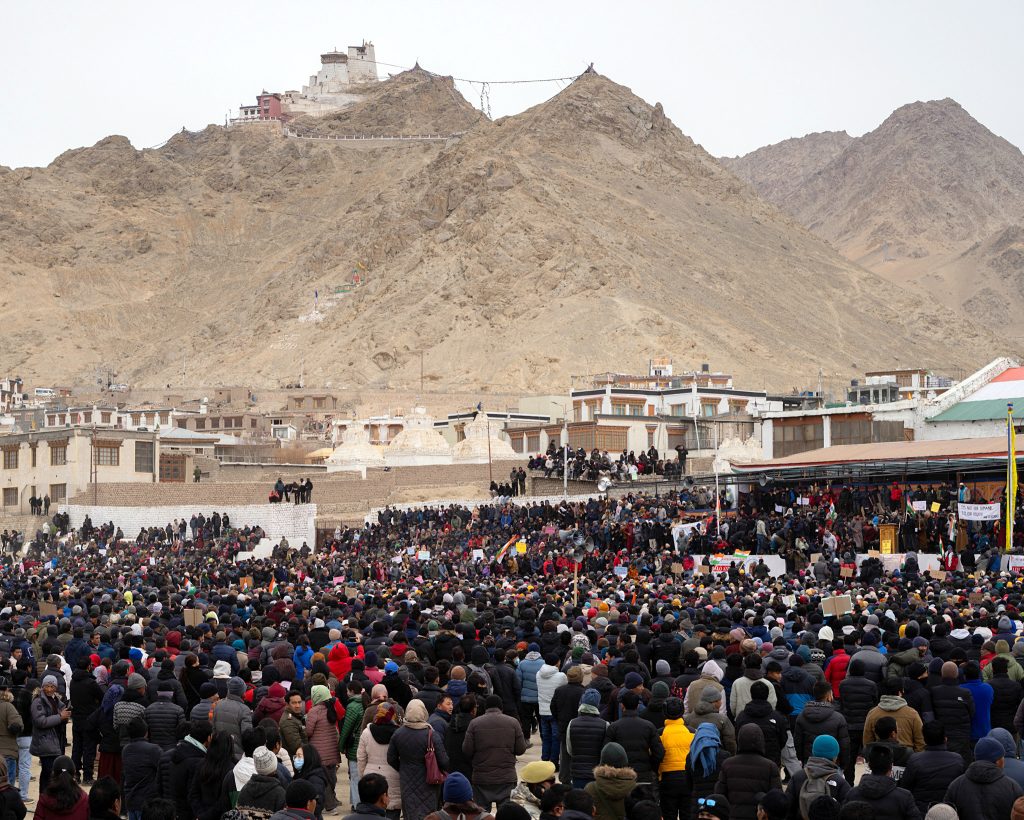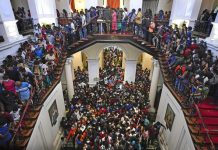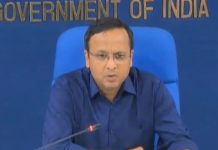Five years after the withdrawal of Article 370, Ladakh feels disempowered. Although the centre has announced some safeguards to address the region’s anxiety about potential demographic changes, the move has failed to resonate with the people of Ladakh. A report by Riyaz Wani

On February 6, thousands of protesters, braving intense cold, gathered at the Polo Ground in Leh. The speeches at the gathering, including those by prominent Ladakhi leaders and activists like Sonam Wangchuk, sought the fulfilment of the promises made by the Union government.
The Leh Apex Body (LAB) and Kargil Democratic Alliance (KDA) which are spearheading the agitation, are demanding special rights and statehood for Ladakh, which was downgraded to a Union territory without a legislature on August 5, 2019. Prior to that, Ladakh was a part of Jammu and Kashmir, which also was made a union territory. The unprecedented step followed the withdrawal of Article 370 that granted the then undivided state a special constitutional position within the Indian Union.
Ironically, the Buddhist majority Leh district in the region had then celebrated the separation from J&K and the grant of union territory status. A UT status was a popular demand from the region going back to the nineties. Once the unimaginable demand was suddenly fulfilled in 2019, Ladakhis have slowly become conscious of drawbacks of the move which they think has disempowered them and also made them vulnerable to demographic change. Hence, the demand for constitutional safeguards under 6th Schedule.
In the new scheme of things, the democratically elected Ladakh Hill Development Councils (LAHDCs), both of Leh and Muslim majority Kargil, which acted autonomously in undivided J&K have become redundant. The region is now directly ruled by the centre through a Lieutenant Governor. So, LAHDCs effectively mean little for regional empowerment.
Ladakhis have now been making a strong pitch for statehood for the region. But the region hardly qualifies for statehood with a population of just over three lakh. This has created a quandary for the union government. More so, at a time when it has no immediate plans to even restore statehood to Jammu and Kashmir.

The total population of Ladakh, according to the 2011 census is 2.74 lakh. While Leh with a population of 1,33,487 is Buddhist majority, Kargil with a population of 1,40,802 is Muslim majority. Overall, Ladakh has a slim Muslim majority.
The fear of the change in demography has brought the people of Leh and Kargil together. It is the first time in decades, the two Ladakh districts have been on the same page in pressing the union government to fulfill their demands for statehood and protection of rights.
The number of demands have since grown. The demands put forth by LAB and KDA include tribal status for Ladakh, inclusion in the constitution’s Sixth Schedule, job reservation for locals, and a parliamentary seat each for the Leh and Kargil districts. Ladakhis are citing the cases of Mizoram, Tripura and Sikkim which are protected by special constitutional provisions.
Last year, the Ladakh Tourist Trade Alliance (LTTA), a coalition of trade, tourism, religious, and political organizations in Leh, passed a resolution opposing investment by outsiders in the tourism sector of Ladakh. The alliance warned that if such investments continue, they would impose restrictions on these investors through non-cooperation from the local travel trade fraternity, as well as community and political organizations.
The alliance, comprising several prominent associations such as the All Ladakh Tour Operators Association Leh, All Ladakh Hotel and Guest House Association Leh, Ladakh Taxi Operators Cooperative Union Leh, and others, has joined forces with various religious and political bodies. Their collective aim is to safeguard the tourism industry of Ladakh and protect the interests of the local people.
Centre’s response so far
In 2021, the centre took steps to address Ladakh’s anxiety about any potential change to its demography by giving it some safeguards. The administration of Ladakh announced that it would issue “Resident Certificates” only to holders of Permanent Resident Certificates as was the case before the withdrawal of J&K autonomy when Ladakh was a part of the undivided state.
This is unlike Jammu and Kashmir where the administration has allowed outsiders who have stayed in the region for a particular duration to apply for permanent residency rights and also buy land.
According to the Ladakh Resident Certificate Order 2021, “any person who possesses a Permanent Resident Certificate (PRC) issued by the competent authority in the districts of Leh and Kargil or belongs to a category of persons who would have been eligible to be issued PRC shall be eligible to receive the ‘Resident Certificate’.”
Future imperfect
As the situation has turned out, the centre’s concession has not satisfied Ladakh. The negotiations with the centre are on. The committee formed by the Union home ministry held talks with LAB and KDA on December 4, but the lack of significant breakthroughs reveals the complexity of the issues at hand. The upcoming second round of talks on February 19 in Delhi provides an opportunity for the government to engage in a meaningful dialogue and address the genuine concerns of the people of Ladakh.
Sonam Wangchuk, a prominent advocate for constitutional safeguards for Ladakh, has announced plans to undertake a fast unto death starting February 19 to intensify the campaign. The Leh Apex Body, led by Wangchuk, has been persistently seeking the inclusion of Ladakh in the Sixth Schedule of the Constitution, which grants protection for tribal rights.
Details regarding the extent of local residents’ involvement in the upcoming agitation are still being finalized. Wangchuk expressed a growing sense of desperation among the residents, citing unmet demands for safeguards under the Sixth Schedule and the attainment of full statehood for Ladakh.
“First it will be Thupstan Chhewang (former BJP Lok Sabha MP) and me, and if we die, who next and how many? All that roster is being prepared,” Wangchuk said while highlighting the gravity of the situation.
Initially planning a three-week fast from February 3, Wangchuk postponed the initiative at the request of Thupstan Chhewang, the chairman of the Leh Apex Body (LAB). Chhewang urged Wangchuk to await the outcome of the meeting on February 19, where prominent leaders from the Union Territory are scheduled to meet Union Minister of State for Home Affairs Nityanand Rai in New Delhi.
The LAB advocates for Ladakh’s inclusion in the Sixth Schedule, focusing on securing tribal rights. The Kargil Democratic Alliance (KDA), on the other hand, has been pressing for Ladakh’s statehood.
Wangchuk explained the significance of the Sixth Schedule, emphasizing its requirement for consulting local indigenous people on any agenda. The provision entails the establishment of councils with legislative and lawmaking rights, ensuring that industries can operate only with the consent of the local population.
Five years after the withdrawal of Article 370, Ladakh feels disempowered. Before the reorganization of Jammu and Kashmir, Ladakh had four MLAs and two MLCs in the then state Assembly, providing a stronger voice for the region. Now, only one Member of Parliament democratically represents the region.












